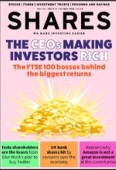Archived article
Please note that tax, investment, pension and ISA rules can change and the information and any views contained in this article may now be inaccurate.
The challenges now facing the big digital advertising players Google and Facebook

Digital advertising experienced a meteoric rise during the Covid pandemic as consumers spent more time online.
Advertisers increasingly reallocated their finite resources away from print and television advertising towards digital.
This was partly because digital advertising appeared to be more financially appealing and also because it promised advertisers the ability to target the right audiences more effectively.
Google-owner Alphabet (GOOG:NASDAQ) and Facebook-owner Meta Platforms (FB:NASDAQ) are the two key beneficiaries of this expansion in digital advertising and both have become increasingly dependent on it as a source of revenue and profit.
Google and Facebook are expected to grab 29% and 21.4% respectively of the $600 billion global online advertising market in 2022.
More than 80% of Alphabet’s revenue comes from Google advertising. No-one is forecasting this revenue will dry up significantly in the short-term. However, investors should be aware of risks which the company may have to overcome if it is to maintain its leading position in the global advertising ecosystem.
A CHALLENGING BACKDROP
First, given the rapidly deteriorating economic environment advertising budgets are likely to slow.
Second, the ability of display advertising to effectively target consumers has been drawn into question given the huge prevalence of fraud, including click farms and automated bots. In addition Google and Facebook will have to contend with new European regulations including the Digital Services Act, which limits how digital giants can target users with online advertisements.
The resurgence in inflation is putting household finances under pressure and will reduce people’s ability to spend on discretionary goods.
The tentative indications of an advertising slowdown were apparent in Alphabet’s recently reported first quarter sales figure of $68 billion.
This was (just) below the average estimate of $68.1 billion, and represented its first miss since the fourth quarter of 2019.
Google’s revenue growth has slowed from 34% in the first quarter of 2021, when the company was reopening from the pandemic, to a current figure of 23%.
The main factor behind the weakness in the reported figures was YouTube advertising sales.
DOES DIGITAL ADVERTISING WORK?
According to marketing outfit WordStream’s analysis of $3 billion in annual advertising expenditure, the average click-through rate (the number of clicks that your advertisement receives divided by the number of times your advertisement is shown) is 2.35%.
In his book entitled Subprime Attention Crisis: Advertising and the Time Bomb at the Heart of the Internet, Tim Hwang maintains that many of the promises about online advertising are flawed.
Hwang highlights the decline in the efficacy of the click-through rate in advertising. Originally in the mid-1990s when the first banner advertisements appeared online the click through rate was almost 50%, one in two people.
Now it is extremely unusual to see a banner advertisement that does better than 0.3% or 0.4%. This suggests there has been a 100-fold decline in the impact of display advertising over a few decades.
CLICK FARMS
A study by the World Federation of Advertising and The Advertising Fraud Council has highlighted the pervasive nature of fraud in digital advertising. The key finding of the report was that 88% of digital advertising clicks are fake.
This is partly due to click farms that are specifically designed to generate internet traffic, and are easily available for hire through resellers on the internet.
Research from click fraud prevention specialist ClickCease revealed the big paid-to-click industry paid out over $13 million to remote workers in 2020.
According to their findings, many of these workers are making approximately $10 a day from hundreds of clicks indicating that remote click farms generate a huge volume of fake clicks of paid advertisements.
Bots are another cause of fraud in digital advertising. These traffic bots are designed to simulate traffic from a live human to trick businesses into thinking their advertisements are getting impressions.
Quoted in a recent article on marketing cyber security platform CHEQ’s website, independent advertising fraud investigator Augustine Fou said: ‘Traffic vendors can sell you all kinds of traffic and you can even select the quality level. Higher quality means the bots work harder and fake more things (like mouse movements, page scrolling and clicks).’ The implications for advertisers are clear.
In the same article Seif Khemaissia, group director at Innocean Worldwide Canada, observed: ‘Somebody would have a huge surge on a day that we launched a campaign and everybody’s patting themselves on the back, saying “Hey we did a really good campaign. We ran all of these leads”.
‘But when those leads come in and you find out that they are all fake, it disrupts the entire reporting system.’
Even advertisements that succeed in circumventing click farms and bots are not likely to be viewed by the people that advertisers are targeting.
A study by MIT professor Catherine Tucker revealed that targeting something as basic as gender was unsuccessful more than half the time. Moreover a Nielsen analysis of a household-income adjusted advertising campaign found that only 25% of its advertisements were reaching the targeted households.
A MORE AGGRESSIVE REGULATOR
On 23 April the European Parliament and EU member states agreed on new legislation limiting how companies like Google and Facebook can target users with online advertisements.
The Digital Services Act will effectively prohibit Google and Facebook from applying algorithms using data based on gender, race and religion to acquire new customers.
The legislation also incorporates new measures to ensure technology giants become more transparent about the nature of algorithms they use to recommend content to clients.
From a financial perspective the new legislation has teeth, and failure to comply with the rules can result in a fine of up to 6% of a company’s global annual revenue.
To put this into perspective, Facebook’s parent company could potentially face a penalty as high as $7 billion based on 2021 sales figures.
REASSESSING DIGITAL ADVERTISING
In a 2021 Forbes article entitled When Big Brands Stopped Spending on Digital Ads, Nothing Happened. Why? Augustine Fou revealed that when Procter & Gamble (PG:NYSE) turned off $200 million of its digital advertising expenditure, it didn’t experience a downturn in sales.
Similarly, when retail bank Chase reduced its programmatic reach from 400,000 sites showing its advertisements to 5,000 there was no change in the level of business.
Ride hailing app Uber (UBER:NYSE) is another example. It cut $120 million from its digital advertising expenditure that was intended to drive more app installs. Yet it saw no change in the rate of installs.
It is far too early to talk about the demise of digital advertising. However, in an increasingly challenging economic environment advertisers may become more discerning about how they allocate their advertising budgets.
This could even play into the hands of the likes of Alphabet and Meta, assuming they can demonstrate they offer a higher quality and more reliable form of digital advertising than the competition.
Important information:
These articles are provided by Shares magazine which is published by AJ Bell Media, a part of AJ Bell. Shares is not written by AJ Bell.
Shares is provided for your general information and use and is not a personal recommendation to invest. It is not intended to be relied upon by you in making or not making any investment decisions. The investments referred to in these articles will not be suitable for all investors. If in doubt please seek appropriate independent financial advice.
Investors acting on the information in these articles do so at their own risk and AJ Bell Media and its staff do not accept liability for losses suffered by investors as a result of their investment decisions.
Issue contents
Feature
Great Ideas
- Find out why WH Smith remains an exciting Covid recovery play
- A tight power market continues to drive earnings upgrades at Drax
- Why we’re sticking with formidable long-run performer Fidelity Special Values
- 2022 should prove a pivotal year for GlaxoSmithKline
- Shares in comparison website owner Moneysupermarket are too cheap to ignore
- This is how to find a winning combination of cheap stocks and inflation protection

 magazine
magazine









